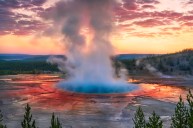Mount St. Helen's devastated the state of Washington when it blew in 1980, killing 57 people in the resulting blast. It's ash was so widespread at the time that it reached Montana two states away. However, could the volcano be showing signs that it's going to blow again?
Recently, St. Helen has been showing a lot of activity under the surface, according to the US Geological Survey. Just how much activity? Well, so far, the volcano has experienced 350 earthquakes since February alone. In the first week of June, Mount St. Helen experienced 38 earthquakes.
For the most part, you wouldn't even notice this geological activity acting under the surface. However, the earthquake on May 31 clocked in at a 2.0 on the Richter scale. So there have been so pretty powerful ripples. It previously experienced two periods of heightened seismic activity from 2023. They "represent the largest short-term increase in earthquake rates since the last eruption ended in 2008," the USGS' Cascades Volcano Observatory in Vancouver, WA wrote.
The 2008 eruption was a minor thing comparatively, but it still spewed up "to pave seven highway lanes three feet thick from New York City to Portland, Oregon," per the USGS. These earthquakes are signs that a volcano is being pressurized. That means it's essentially recharging. Think of a coke can building fizz until the top finally comes off.
Mount St. Helen Has Lots Of Activity
"Magma slowly rises through the lower crust and accumulates in a reservoir about 2.5 to 6 miles (4?'10 km) below sea level," according to Cascades. "Recharge events can occur when magma enters this upper reservoir and increases stresses that lead to earthquakes."
However, experts don't believe that Mount St. Helen is at risk for another eruption. They said the process is perfectly norma for volcanoes, and that volcanoes can go years without an eruption.
"High rates of seismicity, interpreted as recharge, have been observed in the past at Mount St. Helens and at other volcanoes and can continue for many years without an eruption," the observatory noted. "No significant changes have been observed in other monitoring parameters and there is no change in alert levels at this time. Mount St. Helens remains at normal, background levels of activity."




